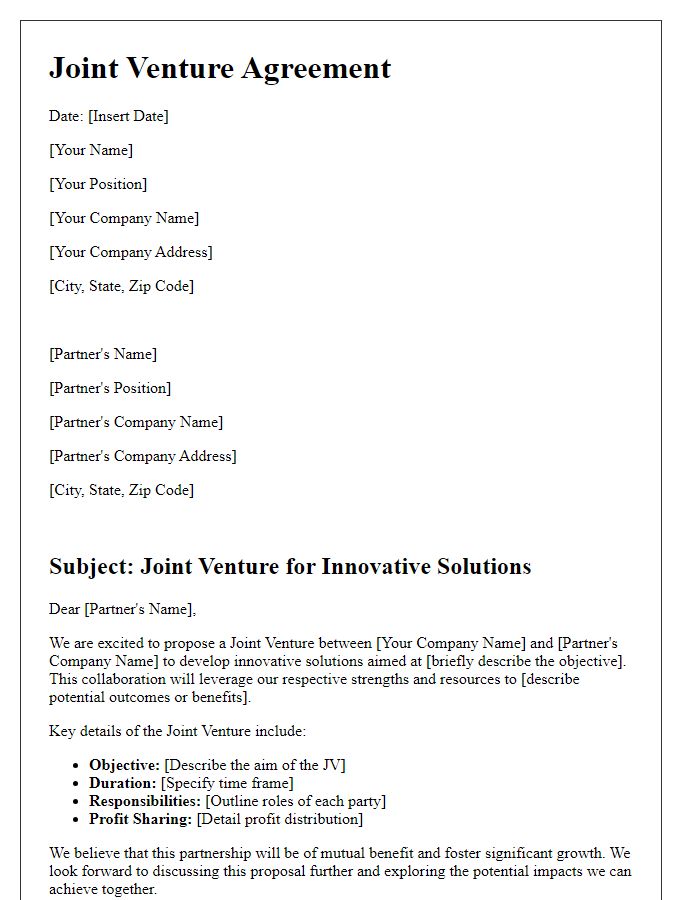Are you ready to explore new horizons in innovation and collaboration? In this article, we will guide you through the essential elements of drafting a partnership agreement that promotes creativity and shared goals. Whether you're teaming up with startups or established firms, crafting a well-structured letter can set the tone for a successful collaboration. So, let's dive in and discover how to create an impactful innovation partnership agreement that works for everyone involved!

Introduction and Purpose
The Innovation Partnership Agreement (IPA) outlines the collaborative framework established between two entities, Company A and Company B, aimed at fostering technological advancements and innovative solutions in the renewable energy sector. This partnership seeks to leverage the unique strengths of both organizations, with Company A specializing in photovoltaic technology (solar energy conversion) and Company B focusing on energy storage systems (batteries and grid integration). The primary purpose of this agreement is to delineate the roles, responsibilities, and contributions of each partner, ensuring a streamlined approach to joint research initiatives and product development. Additionally, this partnership aspires to drive sustainability and efficiency in energy consumption, aligning with global efforts to combat climate change and promote environmental stewardship. By integrating efforts, expertise, and resources, the partners will navigate the complex landscape of renewable energy innovations, ultimately benefiting both organizations and advancing clean technology adoption.
Scope and Objectives
An innovation partnership agreement outlines the collaborative efforts between entities to foster technological advancement and creative solutions. The scope of the partnership includes joint research initiatives, product development, and market testing, focusing on emerging technologies such as artificial intelligence (AI) and Internet of Things (IoT). Objectives encompass creating a framework for knowledge sharing, utilizing resources from both parties, and achieving specific milestones within a defined timeline, such as the completion of a prototype by Q3 2024. This collaboration aims to enhance operational efficiency and drive growth in target markets, leveraging the unique strengths of each organization to achieve mutual benefits and maximize impact in the competitive landscape.
Roles and Responsibilities
In an innovation partnership agreement, roles and responsibilities are critical for defining the collaboration framework. Each partner's contribution must be clearly delineated to ensure the project's success. For example, the Research and Development team may focus on creating prototypes of advanced technologies like Artificial Intelligence algorithms that enhance data processing capabilities. Meanwhile, the Marketing department is responsible for devising strategies to introduce these innovations into emerging markets, such as Southeast Asia with its growing tech landscape. Additionally, legal teams must ensure compliance with local regulations, specifically concerning intellectual property laws that protect innovative ideas. Regular milestones, including monthly progress reports, should be established to monitor performance and facilitate communication between partners, fostering a cohesive working environment.
Intellectual Property Rights
Intellectual Property Rights (IPR) play a crucial role in innovation partnerships, providing legal protection for creations and inventions. Effective agreements require clarity on ownership, usage rights, and protection measures for patents, copyrights, and trademarks. Parties must define specific terms outlining the ownership of new inventions, ensuring that contributions from all partners, including academic institutions and private companies, are recognized. Furthermore, provisions for licensing agreements may also be included, allowing for the commercialization of jointly developed technologies. Effective management of IPR fosters collaboration, encourages investment, and ultimately drives innovation forward in sectors such as technology, pharmaceuticals, and renewable energy.
Termination and Amendments
Termination clauses in innovation partnership agreements outline the conditions under which either party can dissolve the partnership. Common reasons include breach of contract, insolvency, or mutual consent. Amendments to the agreement can be initiated by either party and require written agreement from both parties. These amendments may involve changes in project scope, timelines, or financial commitments. Effective communication is essential during this process to ensure that all parties remain aligned on the partnership objectives and continue fostering innovation. Proper documentation of terminations and amendments safeguards legal interests and clarifies expectations.













Comments